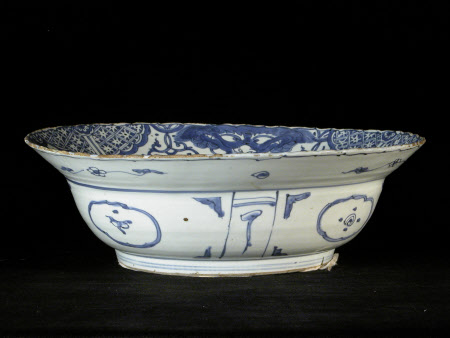Bowl
Category
Ceramics
Date
circa 1620
Materials
Porcelain, cobalt
Measurements
115 mm (Height); 370 mm (Diameter)
Place of origin
Jingdezhen
Order this imageCollection
Saltram, Devon
NT 870897
Summary
Bowl, porcelain, round with a wide, upwardly angled rim (klapmuts type) with a lobed and pointed edge, made in Jingdezhen, Jiangxi Province, China, Wanli period (1572–1620), c. 1620, decorated in underglaze blue in the kraak style with a dragon surrounded chasing a wish-granting jewel and surrounded by ruyi symbols and flames in the centre, rectangular, lobed and pointed panels with auspicious objects separated by stylised pendants on the sides, the rim with four taotie 饕餮 (monster or ‘glutton’) masks alternating with rounded, lobed and pointed panels of diaper pattern, the exterior with sketchily painted lobed and pointed panels with flowers.
Full description
The trilobed ruyi 如意 (‘as you wish’) symbol features as the head of the ceremonial or decorative sceptre of the same name, which was thought to generate good fortune. In the image on this bowl, the ruyi reinforce the power of the wish-granting jewel being chased by the dragon (Bjaaland Welch 2008). The flickering flames signal the presence of a supernatural being. The word kraak appears to have been a garbled Dutch version of the Portuguese caracca, the term for a type of ship used in the trade with East Asia (Kerr and Mengoni 2011). It was the Portuguese who first brought this type of Chinese export porcelain to Europe in the 16th century. The klapmuts was a modest type of headgear in the 17th-century Dutch Republic, a kind of bucket hat, which this type of Chinese porcelain bowl was thought to resemble.
Provenance
Acquired by the National Trust, 1957.
References
Kerr and Mengoni 2011: Rose Kerr and Luisa E. Mengoni, Chinese Export Ceramics, London, 2011, p. 22 Bjaaland Welch 2008: Patricia Bjaaland Welch, Chinese Art: A Guide to Motifs and Visual Imagery, Tokyo, Rutland (Vermont) and Singapore, 2008, p. 125

